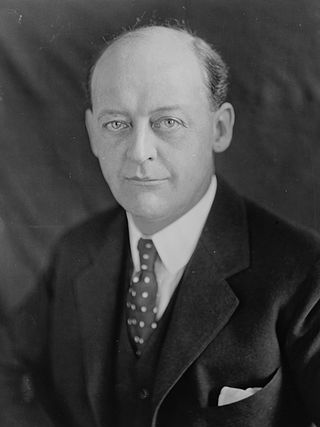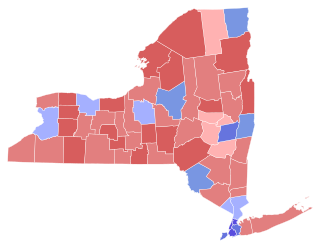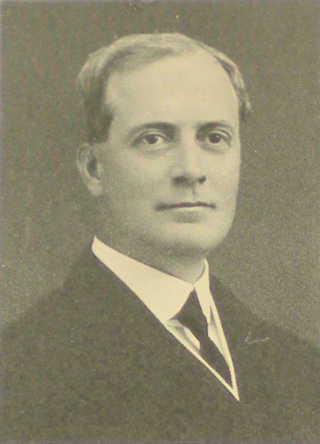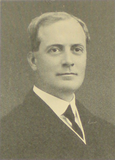
The 1964 United States Senate elections were held on November 3. The 33 seats of Class 1 were contested in regular elections. Special elections were also held to fill vacancies. They coincided with the election of President Lyndon B. Johnson by an overwhelming majority, to a full term. His Democratic Party picked up a net two seats from the Republicans. As of 2023, this was the last time either party has had a two-thirds majority in the Senate, which allowed the Senate Democrats to override a veto, propose constitutional amendments, or convict and expel certain officials without any votes from Senate Republicans. However, internal divisions would have prevented the Democrats from having done so. The Senate election cycle coincided with Democratic gains in the House in the same year.

James Wolcott Wadsworth Jr. was an American politician, a Republican from New York. He was the son of New York State Comptroller James Wolcott Wadsworth, and the grandson of Union General James S. Wadsworth.

The 1944 United States Senate elections coincided with the re-election of Franklin D. Roosevelt to his fourth term as president. The 32 seats of Class 3 were contested in regular elections, and three special elections were held to fill vacancies.

The 1958 New York state election was held on November 4, 1958, to elect the governor, the lieutenant governor, the state comptroller, the attorney general, a judge of the New York Court of Appeals and a U.S. Senator, as well as all members of the New York State Assembly and the New York State Senate.

The 1930 New York state election was held on November 4, 1930, to elect the governor, the lieutenant governor, the state comptroller, the attorney general and a judge of the New York Court of Appeals, as well as all members of the New York State Assembly and the New York State Senate.

The 1928 New York state elections were held on November 6, 1928, to elect the governor, the lieutenant governor, the state comptroller, the attorney general, a U.S. Senator and a judge of the New York Court of Appeals, as well as all members of the New York State Assembly and the New York State Senate.

The 1926 New York state election was held on November 2, 1926, to elect the governor, the lieutenant governor, the state comptroller, the attorney general, a U.S. Senator, the chief judge and an associate judge of the New York Court of Appeals, as well as all members of the New York State Assembly and the New York State Senate. A referendum to repeal Prohibition was also proposed and accepted by a very large majority.

The 1914 New York state election was held on November 3, 1914, to elect the governor, the lieutenant governor, the Secretary of State, the state comptroller, the attorney general, the state treasurer, the state engineer, a U.S. Senator and a judge of the New York Court of Appeals, as well as all members of the New York State Assembly and the New York State Senate, and delegates-at-large to the New York State Constitutional Convention of 1915.

The 1932 New York state election was held on November 8, 1932, to elect the governor, the lieutenant governor, the state comptroller, the attorney general, the chief judge, a U.S. Senator and two U.S. Representatives-at-large, as well as all members of the New York State Assembly and the New York State Senate.

The 1964 United States Senate election in New York was held on November 3, 1964. Incumbent Republican U.S. Senator Kenneth Keating ran for re-election to a second term, but was defeated by Robert F. Kennedy.

The 130th New York State Legislature, consisting of the New York State Senate and the New York State Assembly, met from January 2 to July 26, 1907, during the first year of Charles Evans Hughes's governorship, in Albany.

The 131st New York State Legislature, consisting of the New York State Senate and the New York State Assembly, met from January 1 to June 11, 1908, during the second year of Charles Evans Hughes's governorship, in Albany.

The 132nd New York State Legislature, consisting of the New York State Senate and the New York State Assembly, met from January 6 to April 30, 1909, during the third year of Charles Evans Hughes's governorship, in Albany.

The 134th New York State Legislature, consisting of the New York State Senate and the New York State Assembly, met from January 4 to October 6, 1911, during the first year of John Alden Dix's governorship, in Albany.

The 138th New York State Legislature, consisting of the New York State Senate and the New York State Assembly, met from January 6 to April 24, 1915, during the first year of Charles S. Whitman's governorship, in Albany.

Franklin Webster Cristman was an American lawyer and politician from New York.

The 1914 United States Senate election in New York was held on November 3. Incumbent Republican Senator Elihu Root chose not to seek re-election. James Wolcott Wadsworth Jr. was elected to a succeed Root, defeating Democrat James Watson Gerard.

The United States Senate election of 1920 in New York was held on November 2, 1920. Incumbent Republican Senator James Wolcott Wadsworth Jr. was re-elected to a second term over Democratic Lieutenant Governor Harry C. Walker.

The 1926 United States Senate election in Indiana took place on November 2, 1926. Incumbent Republican Senator James E. Watson was re-elected to a second full term in office over Democratic attorney Albert Stump.

The 1940 United States Senate election in New York was held on November 5, 1940. Incumbent Democratic Senator James M. Mead, first elected in 1938 to fill vacancy caused by the death of Royal S. Copeland, was re-elected to a full term in office, defeating Republican Bruce Barton.





















